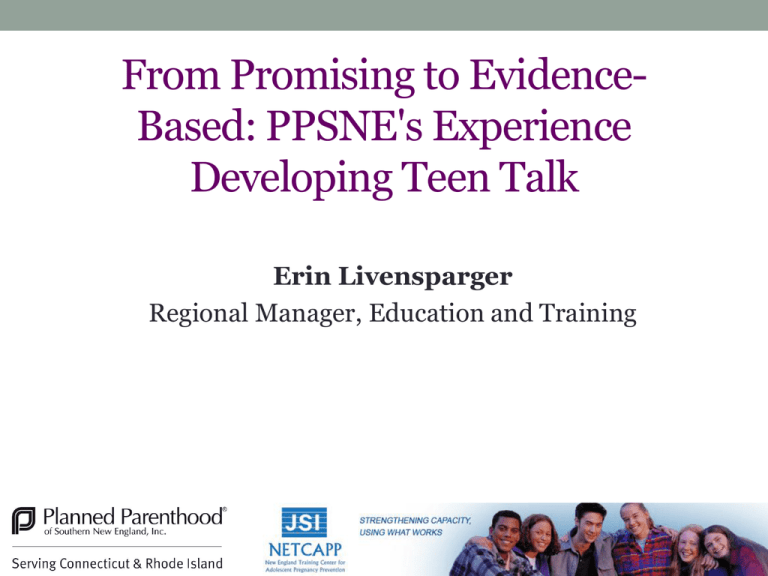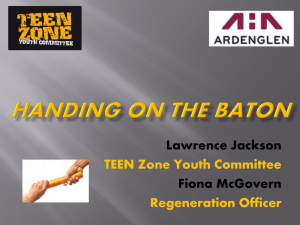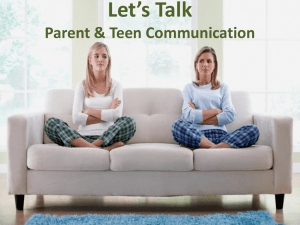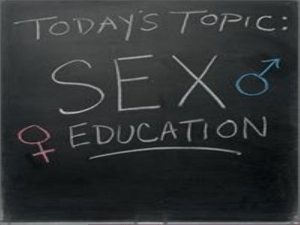
From Promising to EvidenceBased: PPSNE's Experience
Developing Teen Talk
Erin Livensparger
Regional Manager, Education and Training
What is Teen Talk?
• 4 educational sessions covering:
•
•
•
•
•
Reproductive Anatomy
Contraception and
Abstinence
STI’s and Safer Sex
Healthy and Unhealthy Relationships
• Includes a Tour of the Health Center
• Takes Place at PP health centers
• Bridgeport, New Haven, Hartford, Meriden, Stamford, New
London, and Providence, RI
• Provides vouchers for free reproductive health
services
Unique Features of the Curriculum
• Teen Talk has proven to be accessible to
young people even in a non-traditional
learning setting.
• It takes place outside the classroom in an actual
health center setting (or as close to a health
center as possible).
• The third day of activities includes a tour of an
actual reproductive health center.
• Teen Talk also relies on peer to peer
recruitment.
4
The Adolescent Brain: A work in progress
Teen Talk’s Health Goals:
• To decrease rates of teen pregnancy and
STI/HIV among area teens aged 14-17
• By increasing the use of condoms
• By increasing the use of contraception
• By reducing the number of sexual partners
• By reducing frequency of sex
• To increase young people’s comfort with
accessing reproductive health care
How did we do it?
• Collaborated with JSI
• (JSI Research & Training Institute/NETCAPP)
• Held a GTO (Getting to Outcomes) Training
• Used a BDI Logic model
• Created Pre, Post, and Follow-up Tests
• Created Fidelity Check Lists
• Used a Data Planning Matrix
• Tracked how many participants accessed care
after participating in the 4 sessions
• Involved PP Peer Educators (STARS)
• Involved Local Agencies
Teen Talk Logic Model
Activities
Strategies/Methods used in sessions:
•Mini-lecture
•Brainstorming
•Small and Large group discussion
•Group exercises
•Problem solving matching activities
•Values discussions
•Quick quiz/review in the form of a ball toss
•Simulation using anatomy models
•Skills teaching using condoms
•Short case scenarios
•Role-plays
•Health center field trip
•Song analysis
Session 1 Activity Topics:
•Language of Sexuality
•Reproductive Anatomy and Physiology
•Menstruation
•Pregnancy
•Sexual response (as a biological response and
feeling)
Session 2 Activity Topics:
•Attitudes/Feelings about birth control & pregnancy
•Pregnancy options
•Birth control methods
•Condom demonstration and practice
Session 3 Activity Topics:
•Condom demonstration and practice
•Sexual behaviors and risks
•STI information/symptoms/testing
•Health center tour
Session 4 Activity Topics:
•Healthy vs. Unhealthy relationships
•Media influences on sex and relationships
•Using information/skills learned in Teen Talk to
stay healthy
Determinants
(Risk and Protective Factors)
Increase knowledge about:
•
Reproductive anatomy,
puberty, pregnancy,
contraception, and STD/HIV
•
How to access reproductive
health services
Increase personal belief that:
•
Contraception and STD/HIV
prevention is important
•
Condoms do not necessarily
reduce sexual pleasure
Increase positive attitudes about:
•
Condoms/contraception
•
Healthy relationships
•
Accessing reproductive health
services
Increase motivation and intent to:
•
Avoid pregnancy, HIV and
other STDs
•
Avoid unhealthy relationships
Behaviors
•Increase the
use of condoms
•Increase the
use of
contraception
•Reduce
number of
sexual partners
•Reduce
frequency of
sex
Health Goal
To decrease
rates of teen
pregnancy
and
STD/HIV
among area
teens aged
14-17.
8
SIECUS: http://siecus.org/
Session 1 Learning Objectives:
• After completing this lesson, participants will be
able to:
• Identify several group agreements for how the group will
•
•
•
•
interact.
List at least three female and three male reproductive
body parts.
Describe how pregnancy occurs.
Explain the menstrual cycle and identify when a woman
is most fertile.
List at least two physical changes when a person
becomes sexually aroused.
Session 2 Learning Objectives:
• After completing this lesson, participants will be
able to:
• Identify two locations where a person can obtain
methods to prevent pregnancy.
• Formulate a list of four or more ways a person can
prevent pregnancy.
• Identify the options a woman has when she becomes
pregnant.
• Demonstrate steps for correct condom use.
Session 3 Learning Objectives:
• After completing this lesson, participants will be
able to:
• Identify three symptoms of an STD/STI.
• List two or more ways a person can prevent a STD/STI.
• Identify behaviors that put a person at risk for a
STD/STI, including HIV.
• List three or more places where a person can go to for
help if they think they have an infection.
• Demonstrate steps for correct condom use.
Session 4 Learning Objectives:
• After completing this lesson, participants will be
able to:
• Identify 2 characteristics of a healthy relationship.
• Name 1 way to bring up using condoms with a partner.
• Demonstrate 1 way to bring up using condoms with a
partner.
How many teens made appointments?
• 2007 – in New Haven
• 59 out of 70 teens received vouchers
• 31 of them have made appointments
• 24 kept those appointments
• 2008 – in NH, NL, and BP
• 84 out of 115 teens received vouchers
• 27 of them have made appointments
• 22 kept those appointments
Pre, Post, and Follow-up
• We assessed:
• Who is responsible for birth control?
• How confident are you at using a condom?
• How confident are you that you can say no to sex?
• How do you define a healthy relationship?
• What do you know about birth control methods?
• What do you know about reproductive health
services?
• What do you know about STI’s?
2011 Data
We saw an increase in Knowledge:
• The % of youth who correctly identify male and female
body parts by clinical names increased by roughly 13%
• The knowledge about how STIs affect the body
increased. Youth were able to better answer questions
about symptoms of STIs 10% of the time
• We also saw a 3% increase in them knowing that STDs
can be asymptomatic
• Their knowledge regarding the range of contraceptive
methods increased across the board from 3%for using
condoms to 34% for using a diaphragm
2011 Data
We saw a positive change in their Attitudes and
Behaviors:
• We saw an11% increase in feeling like they could
negotiate condom use if they needed to
• There was a 33% increase in their feeling comfortable
talking with a partner about condoms in general
• They also expressed more confidence in feeling like
they could delay sex if they don’t want to have it – after
Teen Talk 16% more participants said they could delay
sex if they wanted to
Teen
Feedback:
• “I thought I knew what I needed until I came here and I
think they (my friends) would learn a lot from it like I
did.” – Teen
• “It teaches things most health classes in school don’t.” –
Teen
• Because of this program, I… “get birth control and use it
like when your getting ready to have intercourse, use a
condom.” – Teen
Diverse Reach
• In the 5 sessions of Teen Talk in New Haven during
calendar year 2011, with 128 students participating.
• Of these students
• 82% were female
• 18% were male
• 62% identified as Black
• 16% as Latino
• 13% as multiracial
• Seventy-seven percent received free or reduced price
lunches at school.
Support
• PP Medical Providers noted that teens in Teen Talk
were more informed
• The second time we ran Teen Talk a Parent filled her
mini-van with teens and brought them for next three
rounds
• A Grandmother drove her granddaughter and friend
each night
• Many Residential Programs bused youth to Planned
Parenthood – this triggered us to apply for State PREP
money
State PREP
Funding Agency: US Department of Health and Human
Services: Administration for Children and Families
awarded funding to the State of Connecticut Department
of Public Health
Geographical Area: State of the Connecticut
Focus Population: 13-19 year olds in Department of
Child and Families care
Activities: To develop and implement an educational
intervention covering abstinence and contraception to
reduce pregnancy, sexually transmitted infections
including HIV/AIDS…AKA Teen Talk
Lessons Learned & Future Directions
• Working with JSI/NETCAPP to make Teen Talk
into a Promising Program
• Use the power of friends
• Buses run late, school breaks are hard, rain not
shine
• Keep in mind regional differences when
expanding
• Educator style and fidelity is important
• Don’t underestimate the Data Planning Matrix
• Spanish
• Working on a training for new Teen Talk
educators
22
They are not giving you a hard
time…they’re having a hard time.
Teen Talk para Latinos
http://www.youtube.com/watch?v=-YAikz0LGTw
Giving Thanks
Myriam, Stephanie, and Amy at JSI
Renée Best, Jaqui Oropeza, Erika Boulware, Tasha
Blanco-Douglas, Mariel Orengo, and Ivelisse Silva
Susan Hellen and Emily Gold
Pierrette Silverman and Kimball Cartwright
Jeremy Stone, Ruth Fontilla, and Lisa Marella
CDC
Healthy Teen Network
STARS (Students Teaching About Responsible
Sexuality)
It is more important to be kind, than right
How to reach me
Erin Livensparger
Planned Parenthood of SNE
345 Whitney Avenue
New Haven, CT. 06511
Erin.Livensparger@ppsne.org
203-752-2852





